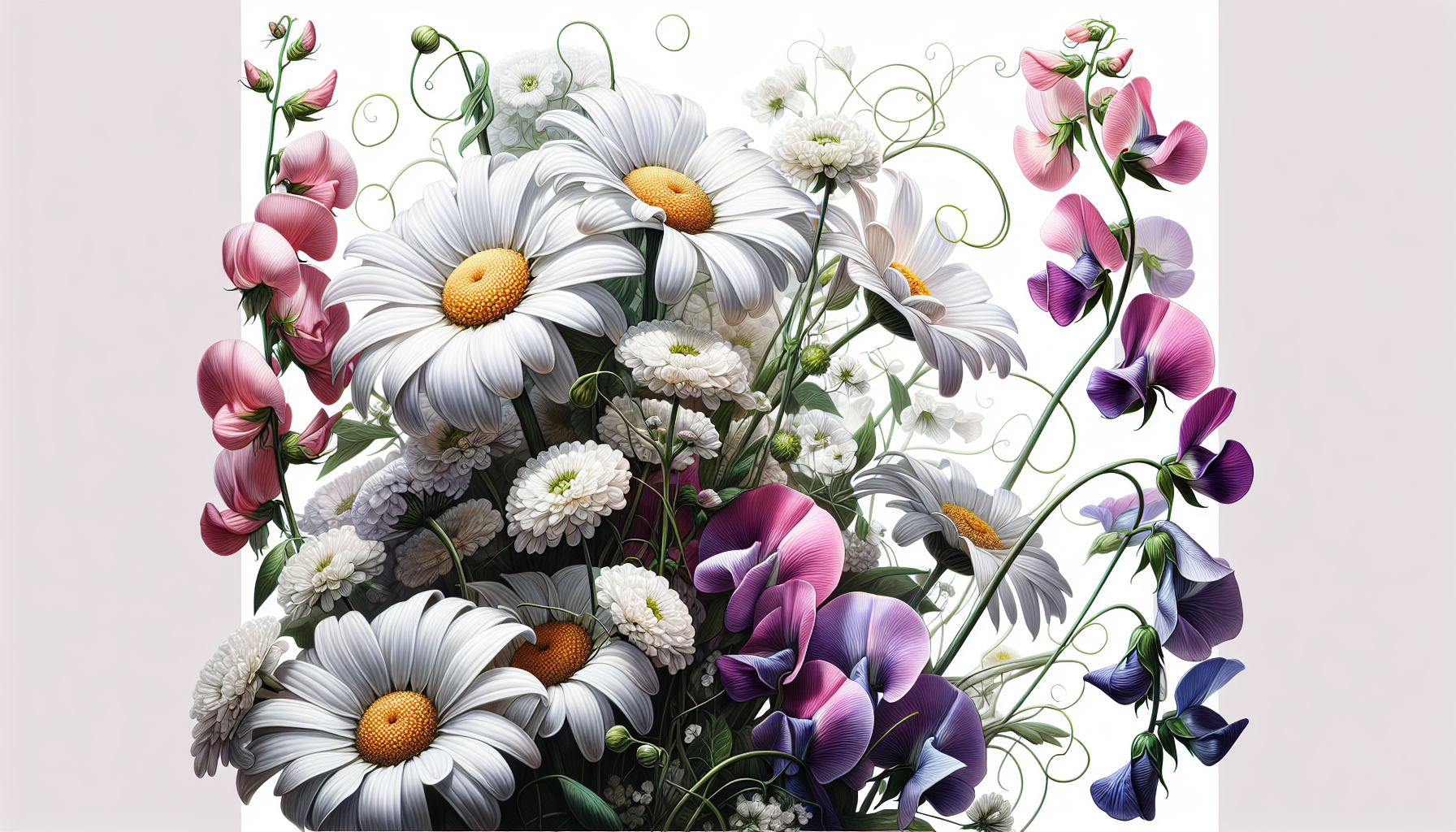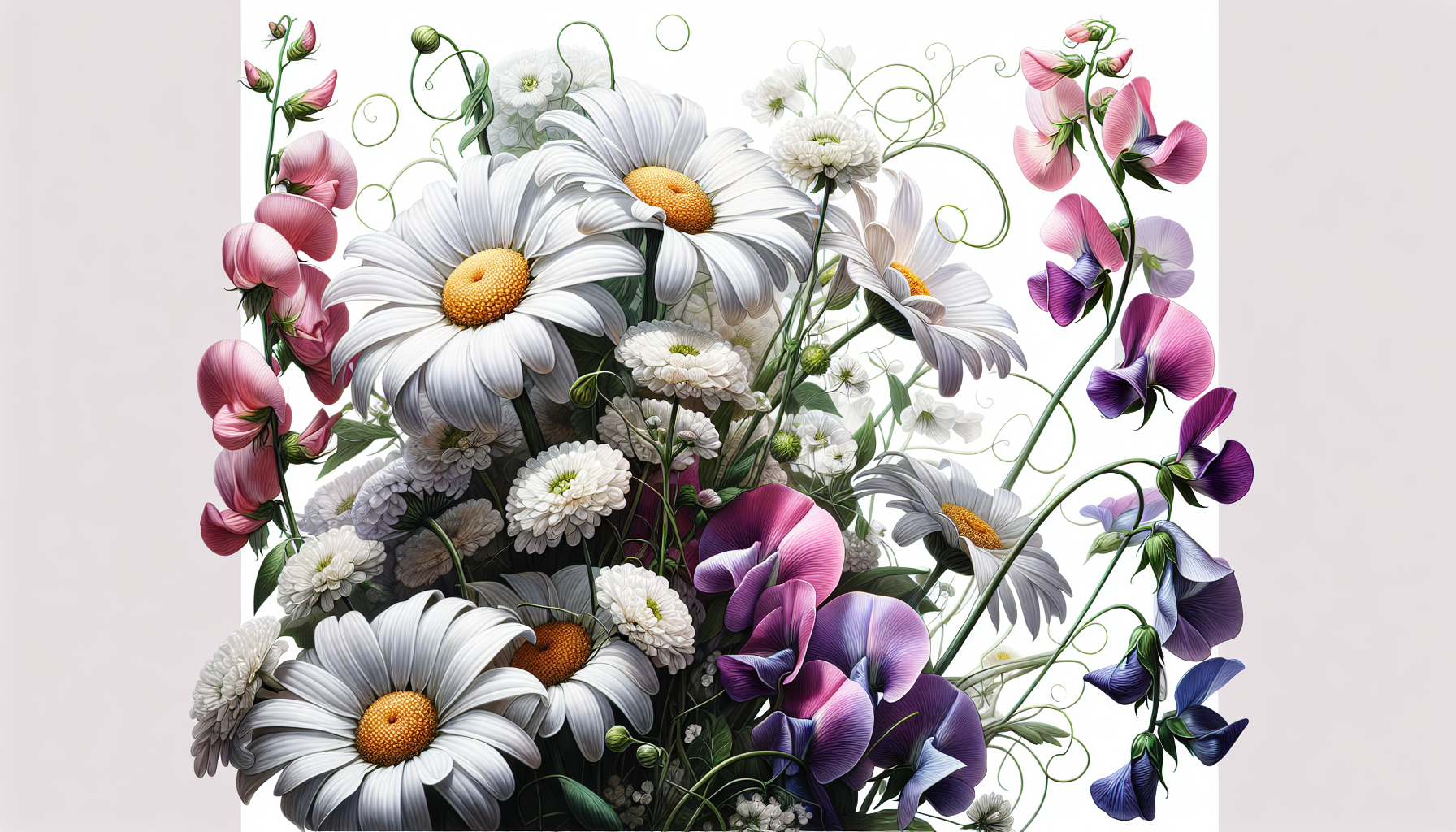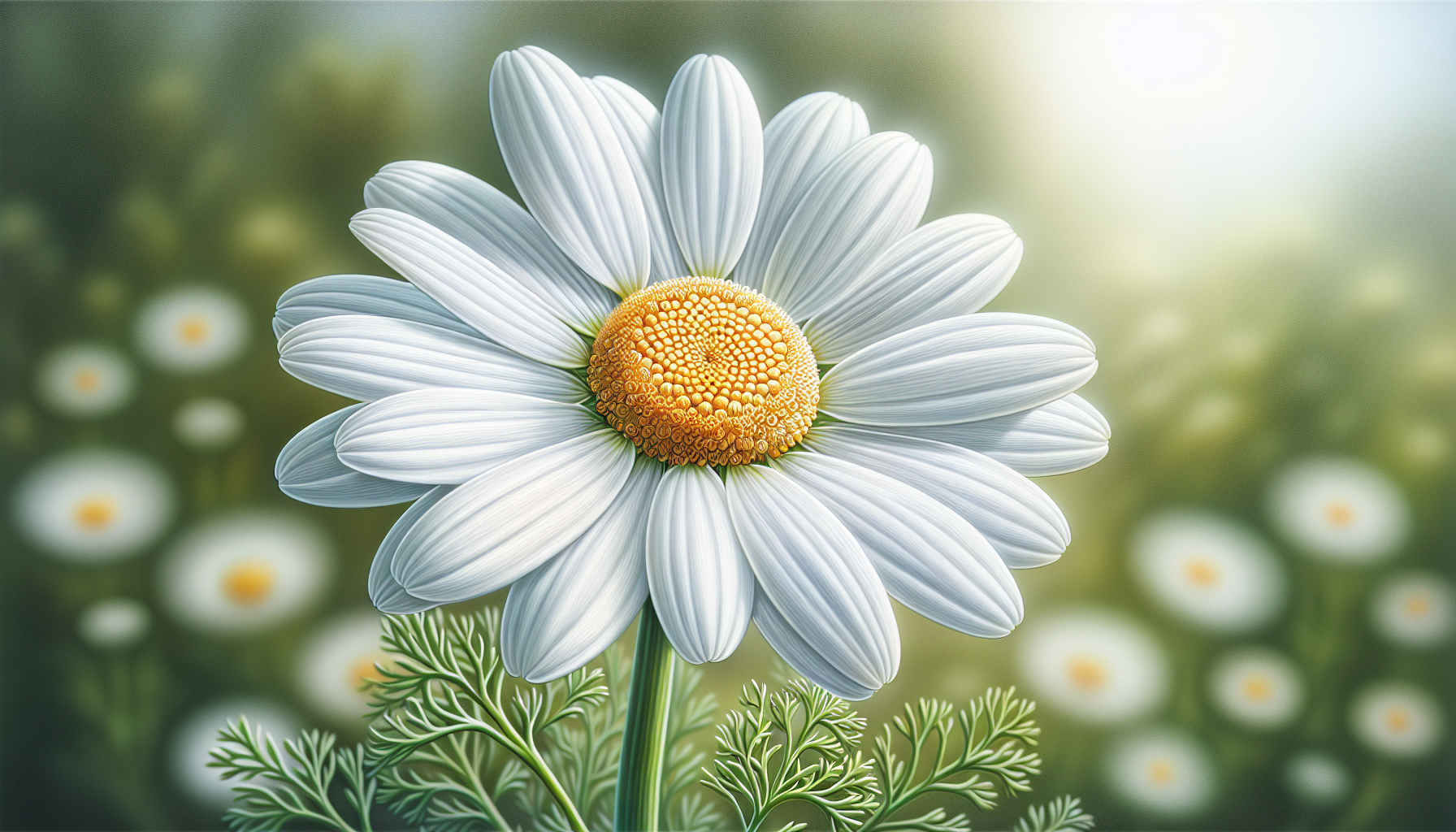The Daisy and Sweet Pea: Flower of the Month for April Birth Flower
April’s flower of the month for April celebrates the cheerful daisy and fragrant sweet pea. Perfect emblems for spring, they blend charm and freshness into every bouquet and garden. Our exploration will take you through their meanings, cultural significance, and why they’re the heart of April’s floral scene.

Daisy and Sweet Peas
- The daisy and sweet pea are great gifts for April birthday flowers, each representing a different set of symbols and attributes; daisies symbolize purity, innocence, and new beginnings, while sweet peas denote pleasure, goodbyes, and thanks.
- Both flowers have deep historical roots and were valued for their medicinal properties, with daisies being found in ancient medicinal texts and sweet peas hailing from the Aegean Islands with qualities believed to ward off evil spirits.
- Caring for these birth flowers requires specific conditions such as fertile, well-draining soil and appropriate sunlight or support structures, with practices like deadheading and regular inspections being essential for prolonged health and blossoming.
April's Floral Emblems: Daisy and Sweet Pea

In the floral calendar, April stands out with not one, but two exquisite birth flowers: the daisy and the sweet pea. These blooms offer a delightful array of colors and fragrances, providing a personal touch for those born in this month. The daisy can be found in shades ranging from pure white to sunny yellow, while the sweet pea graces us with its pastel palette of blues, pinks, and purples. With such diversity, April’s floral emblems cater to a variety of tastes, making them a versatile choice for birthday bouquets and a great happy birthday quote.
As we celebrate April birthdays and the renewal of spring, the daisy and sweet pea serve as beautiful reminders of nature’s bounty. These flowers not only enhance the aesthetic of any space but also bring a sense of joy and freshness to our daily lives. Whether arranged in a rustic bouquet or planted in a vibrant garden, daisies and sweet peas are a testament to the beauty and complexity of April’s birth flowers.
The Delightful Daisy

The daisy, with its iconic white petals radiating around a sunny center, has long been a symbol of purity, innocence, and new beginnings. Its simple beauty and the cheerful disposition make it a favorite among gardeners and flower enthusiasts alike. The daisy family is diverse, including varieties such as:
- Ox eye
- Shasta
- Gerbera
- English daisy
Each adding its unique touch to the floral world. With vibrant colors that span the spectrum from white to yellow, pink, red, purple, and orange, there is a daisy to match every mood and occasion.
Gerbera daisies, in particular, are beloved for their wide range of hues and long-lasting blooms, making them a splendid choice for cut flower arrangements. Their cheerful faces seem to capture the very essence of a blissful spring day, offering a burst of color that enlivens any room. Whether nestled in an English garden or gracing a simple vase on the kitchen table, these beautiful flowers bring a touch of joy and innocence that is reminiscent of the first days of spring.
The Sensational Sweet Pea

Sweet peas, with their delicate tendrils and ruffled petals, are the epitome of vintage charm. These blossoms carry a sweet fragrance that is often likened to a blend of oranges, honey, and jasmine, making them a favorite for perfumers and gardeners alike. Their colors, ranging from soft whites to deep pinks and purples, evoke a sense of gratitude, good wishes, and appreciation. In the language of flowers, sweet peas are associated with blissful pleasure, a fitting tribute to the warm and inviting days of April.
The allure of the sweet pea is not limited to its beauty and scent; it also holds a special place in the heart as a thoughtful gift. A bouquet of mixed-colored sweet pea blooms is a visual and olfactory delight, perfect for conveying feelings of appreciation or wishing someone a heartfelt goodbye.
Whether presented to a dear friend or adorning a festive event, sweet peas add a touch of elegance and sweet fragrance that is truly unforgettable. Their history sweet peas have made them a popular choice for many occasions.
The Historical Roots of April's Birth Flowers
Delving into the annals of history, both the daisy and sweet pea boast ancient origins and a legacy of medicinal and cultural significance. Daisies have been found in the earliest known medicinal texts, suggesting their use in healing and the treatment of various ailments since time immemorial. Similarly, sweet peas, hailing from the Aegean Islands, have enchanted the senses with their unique fragrance since ancient times. In fact, ancient Romans believed the scent of sweet peas had the power to ward off evil spirits, highlighting the plant’s historical and cultural importance.
Beyond their aromatic allure, these flowers have also played significant roles in traditional medicine. Daisies were valued for their anti-inflammatory properties and were often incorporated into remedies for wounds and diseases. Sweet peas, on the other hand, were recognized for their purgative properties, indicating their medicinal applications throughout history. As we explore the past, it becomes clear that the daisy and sweet pea have been more than just decorative elements; they have been integral to the health and well-being of past civilizations.
Daisies Through the Ages
The daisy’s timeless appeal is rooted in its mythological and historical significance. Revered across various cultures, the daisy was associated with Freyja, the Norse goddess of love, beauty, and fertility, and echoed similar themes in Greek legends. In Roman mythology, the daisy was believed to have divine origins, further cementing its esteemed status in ancient societies. The flower’s journey through time saw it cultivated in Egyptian gardens as early as 2200 B.C., where it served as a remedy for ailments ranging from coughs to inflammation during the Middle Ages and Renaissance.
Native to Europe and Asia, the daisy has been gracing landscapes for over 4,000 years. Its depiction in art and cultural expressions during the Middle Ages has consistently symbolized innocence and purity. The daisy’s enduring charm is a testament to its versatility and significance across centuries, from ancient medicinal uses to artistic and symbolic representations that continue to resonate today.
Sweet Peas' Journey Across Europe
The sweet pea’s odyssey across Europe began in the picturesque landscape of southern Italy, where it was first discovered by the keen eyes of a Sicilian monk named Francis Cupani. In the late 17th century, Cupani shared the beauty of sweet peas with his contemporaries by sending seeds to botanists in Amsterdam and England, effectively introducing these fragrant blooms to a wider audience. Native to the sun-drenched Mediterranean region, sweet peas found a new home in the varied climates of Europe, where they thrived and captivated the hearts of many.
The 1800s marked a significant milestone in the sweet pea’s evolution as Scottish nurseryman Henry Eckard developed larger and more colorful hybrids. These new varieties added to the flower’s burgeoning popularity and diversity, allowing garden enthusiasts to cultivate a breathtaking array of sweet peas. The flower’s journey from a humble Mediterranean native to a beloved European staple is a story of botanical exploration and horticultural innovation, illustrating the sweet pea’s lasting appeal.
Caring for Your April Birth Flowers
To ensure the health and beauty of April’s birth flowers, proper care is essential. Both daisies and sweet peas flourish with the following care:
- Plant them in fertile, well-draining soil.
- Provide them with the right amount of water for optimal growth.
- Daisies thrive in full sun and require a weed-free environment and well-worked soil.
- Sweet peas benefit from structures such as trellises or wire supports that encourage their tendrils to climb and flourish.
As any seasoned gardener knows, vigilance is key when it comes to plant health. Regularly inspecting daisies and sweet peas for signs of disease or pests and promptly addressing any issues can prevent damage and maintain the vitality of the blooms. Additionally, the practice of deadheading, or removing spent flowers, not only keeps the plants looking tidy but also promotes a longer blooming period, ensuring a continuous display of April’s charming birth flowers, including those used as cut flowers.
Daisy Gardening Essentials
Cultivating a thriving daisy garden requires a few key essentials. These sun-loving flowers need:
- at least six hours of full sun exposure each day
- soil that is well-drained to avoid the detrimental effects of excess moisture
- regular watering and feeding
- a weekly deep watering and monthly fertilization, or the use of organic mulch, to provide the nutrients necessary for robust growth and blooming.
Pruning and propagation are integral to maintaining a daisy’s beauty and longevity. Here are some tips to help you with these tasks:
- Regular deadheading encourages more flowers to form.
- Pruning helps keep the plants at a manageable size and shape.
- Every three years, daisies should be divided to promote vitality.
- Repotting in the spring, increasing pot size by one to two inches before outdoor transplantation, ensures they continue to thrive.
These simple yet effective gardening practices can help shasta daisies and wild daisies become vibrant and joyful additions to any outdoor space.
Sweet Pea Planting and Care
Sweet peas are as delightful to care for as they are to behold. Starting sweet pea seeds indoors before transplanting them outside takes advantage of their hardiness in cooler temperatures or light frosts. Providing the right support is crucial for these climbers; structures such as trellises, arches, or fences not only offer practical benefits but also add architectural interest to the garden.
Attentiveness to the presence of pests is crucial for healthy sweet pea plants. Regular monitoring and prompt intervention when pests are detected will protect the delicate blooms and ensure a successful flowering season. With the right care, sweet peas will reward gardeners with their intoxicating fragrance and cascades of colorful blossoms that capture the essence of spring.
Creative Ways to Celebrate with April Birth Flowers
Celebrating special occasions in April can be made all the more memorable with creative touches that incorporate the themes of the daisy and sweet pea. Customized jewelry, for instance, can be fashioned into delicate designs featuring these flowers, offering a personalized and lasting gift. Whether it’s a daisy pendant or sweet pea earrings, such unique pieces can serve as a daily reminder of the beauty of April and the thoughtfulness of the giver.
Beyond traditional bouquets, these floral motifs can be woven into a variety of celebratory elements, including:
- Invitations
- Decorations
- Cakes
- Favors
Embracing the spirit of the season, these creative expressions allow one to infuse any gathering with the charm of April’s birth flowers, creating moments that are as beautiful as they are unforgettable.
Gifting Ideas for April Birthdays
When searching for the perfect gift for someone born in April, consider the significance of the month’s birth flowers. A hand-picked bouquet or artfully arranged flower arrangement that includes daisies or sweet peas is not only seasonal but also deeply thoughtful. The birth flower blooms represent the freshness of spring and the joy of new beginnings, making them an ideal birthday gesture.
For a gift that endures, a potted daisy or sweet pea plant can serve as a living symbol of affection and remembrance. These potted presents offer a lasting reminder of a special day and the continued growth of the relationship between the giver and receiver. With such meaningful options available, choosing a gift for an April birthday becomes a delightful endeavor.
Decorating with Daisies and Sweet Peas
Daisies and sweet peas possess an innate elegance that lends itself perfectly to decorating for festive occasions. Their timeless beauty can enhance events from casual garden parties to formal weddings. In France, sweet peas have traditionally been gifted to brides for good fortune on their wedding day, underscoring their ability to bring a touch of refined beauty and symbolic meaning to any celebration.
Whether used in a bridal bouquet, as table centerpieces, or woven into garlands, these flowers can transform an event space with their vibrant colors and delightful scents. With the versatility and visual appeal of daisies and sweet peas, decorators and hosts alike can create an atmosphere that is both inviting and enchanting.
The Language of Flowers: Daisy and Sweet Pea Meanings
The daisy and sweet pea are steeped in the romantic tradition of floriography, the language of flowers, where each bloom holds a special meaning. The daisy’s structure, with its central eye surrounded by radiating petals, has come to represent true love and loyalty. The various colors of daisies convey different messages:
- White for purity
- Yellow for joy
- Pink for affection
- Red for deep love
This rainbow of sentiments allows the daisy to speak volumes without a single word.
Sweet peas carry equally poignant meanings in the Victorian language of flowers. They symbolize farewell, good wishes, or gratitude, making them a fitting farewell gift or a token of thanks. For those born in April, daisies and sweet peas embody a harmonious blend of gratitude and pleasure, reflecting the essence of the month with their rich symbolism and delightful presence.
Daisy Symbolism and Personality Traits
The daisy’s symbolism extends beyond its physical beauty to the traits it embodies. With links to major goddesses such as the Virgin Mary and Freya, the daisy represents:
- love
- innocence
- fertility
- beauty
In the Victorian era, it also symbolized loyalty and discretion. These associations suggest that individuals connected to the daisy may possess warm-hearted, optimistic, and humorous personality traits, mirroring the flower’s representation of innocence and purity.
The daisy’s ability to evoke cheerfulness and simplicity resonates with those who are lighthearted and approach life with a positive outlook. Just as the daisy brightens gardens and homes with its unassuming beauty, so too do individuals associated with this flower often bring joy and comfort to those around them with their sunny disposition and infectious laughter.
Sweet Pea Significance and Characteristics
The sweet pea’s enduring symbolism of lasting friendships speaks volumes about the nature of April-born individuals, often referred to as “sweet pea April.” These flowers, with their sweet fragrance and delicate blossoms, are reminiscent of the cherished moments shared between friends. Indeed, sweet peas are often given as a token of appreciation, aligning perfectly with the friendly and grateful attributes commonly associated with those who celebrate their birthdays in this spring month.
Moreover, the sweet pea’s charm and variety make it a splendid gesture of gratitude, whether presented as a single blossom or a lavish bouquet. The tradition of gifting sweet peas to show thanks or to acknowledge a special bond is a testament to the flower’s ability to convey deep emotional connections and enduring relationships, reflecting the significance and characteristics that sweet peas symbolize.
Summary
In closing, April’s birth flowers, the daisy and sweet pea, offer a world of beauty, symbolism, and joy. From their rich historical roots to their diverse colors and fragrances, these blooms capture the essence of spring and the celebration of life. Whether used in gardens, bouquets, or as tokens of affection, daisies and sweet peas hold a special place in the hearts of those born in April and all who appreciate the natural splendor of these enchanting flowers. May the daisy and sweet pea inspire you to embrace the beauty of beginnings and the warmth of cherished connections this spring season.
Frequently Asked Questions
Why does April have two flowers?
April has two birth flowers, the daisy and sweet pea, each symbolizing different qualities such as innocence, purity, true love, and delicate pleasure. This allows people to choose the flower they feel a stronger connection with and provides more options for florists and gift-givers when selecting flowers for birthdays or other celebrations.
What is my birth flower if I was born in April?
Your birth flower, if you were born in April, would be the daisy or sweet pea. Both flowers are associated with simplicity, sweetness, and bright colors, making them a delightful choice for a birthday bouquet.
Why are there 2 birth flowers for each month?
Some months have two birth flowers, while others do not, and this is due to different cultural interpretations and regional availability. The pair of flowers chosen usually hold separate meanings that may or may not correspond to the time of year.
What is the symbol for April birthdays?
The zodiac symbols for April birthdays are the ram for Aries and the bull for Taurus. Aries are known for being passionate and confident, while Taurus are thought to be quite sensible and pleasure-seeking.
What do daisies symbolize in the language of flowers?
Daisies symbolize purity, innocence, and true love, with different colors conveying various sentiments such as white for purity, yellow for joy, pink for affection, and red for deep love.

